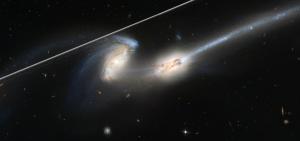A satellite streaks in front of a pair of interacting galaxies in this Hubble Space Telescope image. The number of orbiting satellites is increasing by several thousand per year, presenting a big challenge for the scientists who operate telescopes in space and on the ground. The proliferation also could make it more difficult for casual skywatchers to see the Milky Way, faint meteors, and other cosmic sights. [NASA/ESA/STScI]
You are here
Brighter Skies
The night sky is getting brighter. The main culprit is light pollution – the glow of streetlamps, billboards, and many other artificial light sources. But there’s another source of brightness that’s far outside Earth’s atmosphere: satellites.
The number of satellites is, well, skyrocketing. As many satellites have been placed in Earth orbit in the past five years as in the first six decades of the Space Age. And the pace is picking up. Companies are launching thousands of spacecraft every year. Most of them bring Internet access to underserved parts of the world.
That’s becoming a problem for astronomers. The satellites can form bright streaks in their images of the universe, or block their targets from view.
It’s also becoming a problem for casual skywatchers. The satellites reflect a lot of sunlight, casting a “haze” across the night. And when satellites collide or break apart, they produce thousands of bits of debris, all of which add to the glow.
A recent study reported that the congested space around Earth has already brightened the night sky by about 10 percent. And if the projected launch rate comes true, it could make the sky even brighter. Even under dark skies, away from city lights, that could reduce the number of visible stars by almost a third. And it could make it harder to see meteor showers, faint auroras, and the soft glow of the Milky Way – hiding them behind a high curtain of light.
Script by Damond Benningfield
Get Premium Audio
Listen to today's episode of StarDate on the web the same day it airs in high-quality streaming audio without any extra ads or announcements. Choose a $8 one-month pass, or listen every day for a year for just $30.




